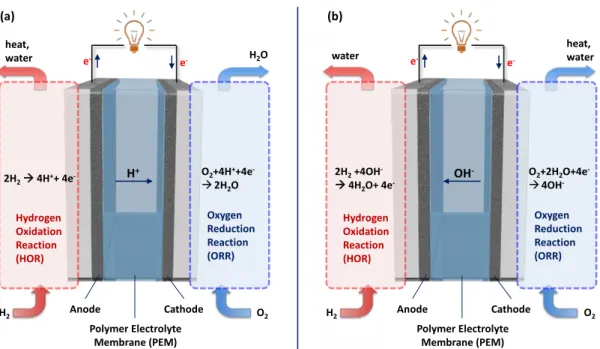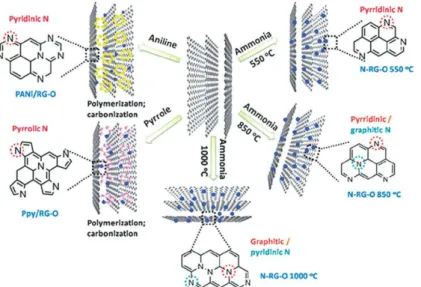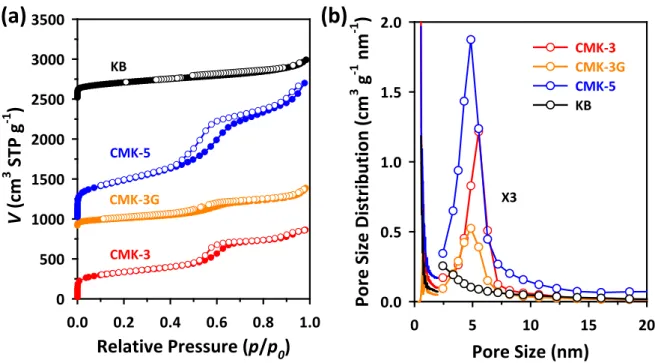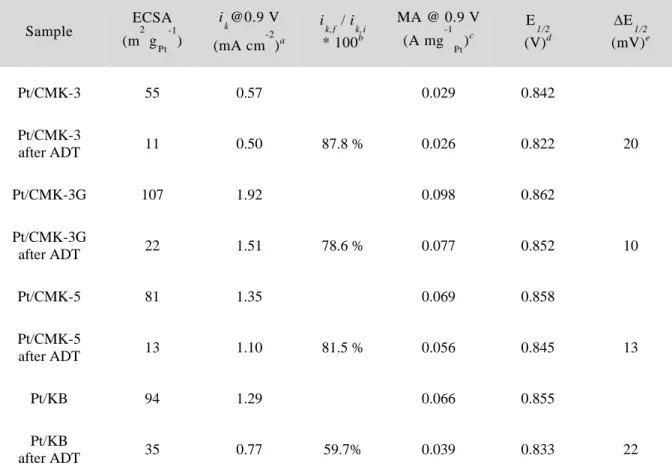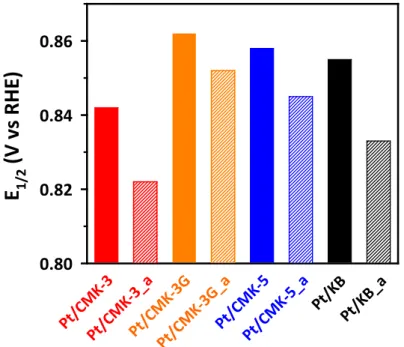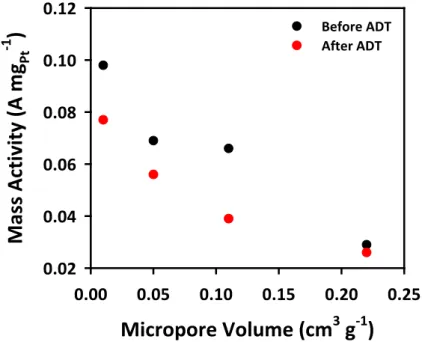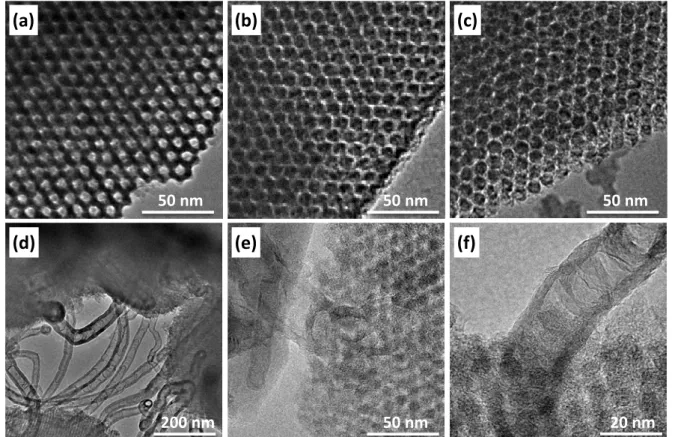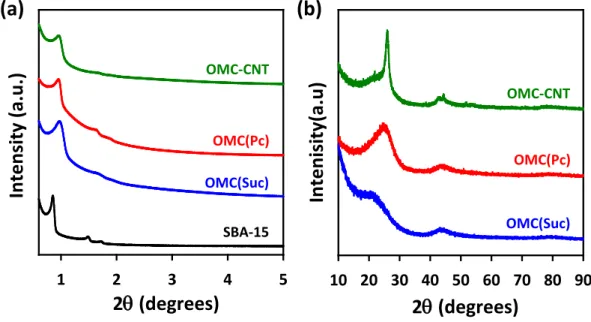The EXAFS and XANES spectra of the GNS/MC catalyst were collected under in situ electrochemical conditions..107 Figure 6.14. TEM image of the GNS/MC catalyst after 10 cycles of the aqueous Na-air battery cell test..113.
GENERAL INTRODUCTION
- FUEL CELL
- Overview of Fuel Cells
- Acidic and Alkaline Hydrogen Polymer Electrolyte Membrane Fuel Cells
- ELECTROCATALYSTS FOR OXYGEN REDUCTION REACTION (ORR)
- Class of ORR Catalysts
- Supported Platinum Catalysts
- Heteroatom-Doped Carbons
- Transition Metal-Nitrogen-Carbon (M-N x /C)
- OUTLINE OF THIS THESIS
- REFERENCES
PAFCs are one of the most mature cell types and the first to be used commercially. AFCs were one of the first fuel cell technologies developed, and they were the first type to be widely used in the US.
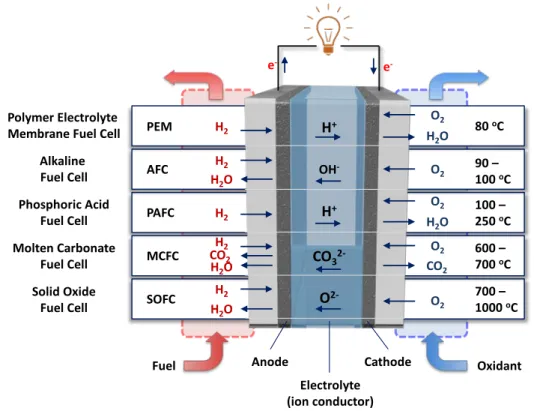
IMPACT OF FRAMEWORK STRUCTURE OF ORDERED MESOPOROUS
- INTRODUCTION
- EXPERIMENTAL SECTION
- Synthesis of Ordered Mesoporous Silica SBA-15
- Synthesis of Ordered Mesoporous Carbons
- Preparation of Supported Platinum Catalysts on Ordered Mesoporous Carbons
- Characterization Methods
- Electrochemical Measurements
- RESULTS AND DISCUSSION
- CONCLUSIONS
- REFERENCES
The electrocatalytic activities of Pt/OMC and Pt/KB catalysts for ORR were investigated using an RRDE method. Another possible reason for the high catalytic activity of the Pt/CMK-3G catalyst is its graphitic carbon framework.
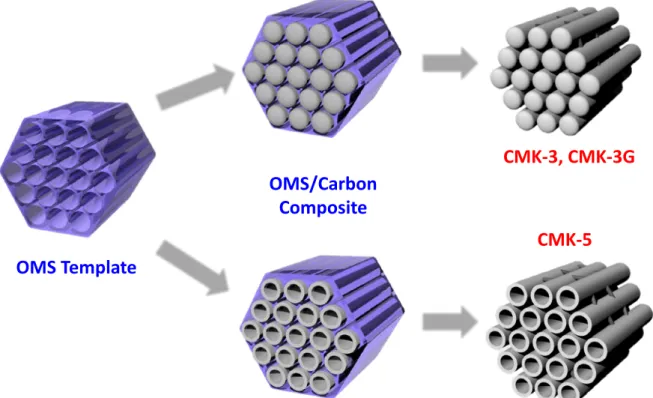
ORDERED MESOPOROUS CARBON-CARBON NANOTUBE NANOCOMPOSITES
INTRODUCTION
The ORR activities and kinetics of the Pt/OMC catalysts were measured by the rotating ring-disk electrode (RRDE) technique. The Koutecky-Levich analysis as well as the H2O2 yield calculation of the catalysts indicated that the ORR over the Pt/OMC catalysts followed a four-electron pathway. Among the three Pt/OMC catalysts, the Pt/OMC-CNT catalyst showed activity that was better than that of the Pt/OMC(Suc) and Pt/OMC(Pc) catalysts.
In single-cell tests that are more relevant to the practical applications, the Pt/OMC-CNT catalyst showed a current density higher than that of the other two catalysts after high-voltage degradation test. The half-cell and single-cell tests with the Pt/OMC catalysts indicated that the rigidly interconnected structure and highly conductive frameworks of the OMC-CNT nanocomposites were simultaneously responsible for their improved durability and single-cell performance.
EXPERIMENTAL SECTION
- Synthesis of Ordered Mesoporous Carbon-Carbon Nanotube Nanocomposite
- Preparation of Supported Platinum Catalyst on Nanocomposite
- Characterization Methods
- Electrochemical Measurements
We believe that this work provides unprecedented insight into the durability of the OMC-based catalysts under realistic, single-cell operating conditions. The morphologies of the samples were determined using a scanning electron microscope (SEM) (Quanta 200, FEI) operating at 18 kV. The internal pore structures of the samples were observed with a transmission electron microscope (TEM) (JEM-2100F, JEOL) at an accelerating voltage of 200 kV.
The porous structures of the samples were analyzed by nitrogen adsorption experiment at -196 °C using a BEL BELSORP-Max system. The surface areas and pore size distributions of the samples were calculated using the Brunauer-Emmett-Teller (BET) equation and the Barrett-Joyner-Halenda (BJH) method, respectively.
RESULTS AND DISCUSSION
Cyclic voltammograms of Pt/OMC catalysts in a 0.1 M HClO4 solution saturated with N2 at a scan rate of 20 mV s-1. The electrochemical properties of Pt/OMC catalysts were investigated by CV and linear sweep voltammetry (LSV) for ORR (Figures 3.10 and 3.11). This opposite trend can be related to the higher micropore volume of the Pt/OMC(Suc) catalyst (see Table 3.1).
The electrocatalytic activities of Pt/OMC catalysts for ORR were investigated using an RRDE method. These results indicated that the stability of the Pt/OMC-CNT and Pt/OMC(Pc) catalysts was greater than that of the Pt/OMC(Suc) catalyst.
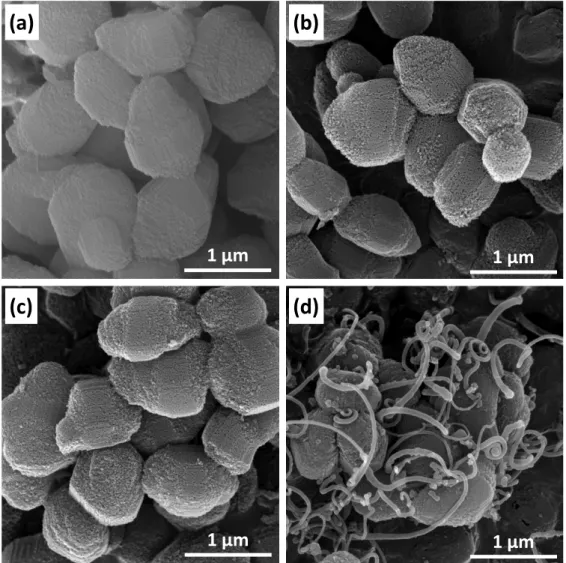
CONCLUSIONS
The ohmic and charge transfer resistances of the three Pt/OMC cathodes before the durability tests were similar. This is indicated by the sizes of the circles in the Nyquist plots being the same. After the high-voltage breakdown tests, the Nyquist plots of the PEMFC showed a clear difference, with the plot of the Pt/OMC-CNT-based PEMFC having the smallest circle.
The charge transfer resistance of Pt/OMC-CNT-based PEMFC was lower than that of PEMFCs based on Pt/OMC(Pc) and Pt/OMC(Suc) catalysts by a factor of 2. This difference can be directly related to the differences in the respective current densities of the catalysts as determined by their polarization curves.
We believe that when considered with the results of our previous study,29 in which we reported the use of OMC-CNT nanocomposites for high-performance counter electrode for DSSC, the results of this study demonstrate the versatility of OMC-CNT nanocomposites as general platform materials for energy conversion and storage devices. Intrinsic relationship between enhanced oxygen reduction reaction activity and nanoscale work function of doped carbons.
INTRODUCTION
EXPERIMENTAL SECTION
- Synthesis of Heteroatom-Doped Ordered Mesoporous Carbons
- Characterization Methods
- Electrochemical Measurements
The infiltration-drying process was repeated with 66 w/w% of the initial reactants with the exception of DI water (5 g). The N,S,O-OMC was obtained after carbonization and acid washing with the procedure as described for the OMC. Linear sweep voltammetry (LSV) curves for the ORR were obtained using a potential cycle from 1.1 to 0.2 V (for Pt/C, LSV curve was obtained from 0.2 to 1.1 to avoid the formation of Pt-O species. ) in an O2-saturated solution of 0.1 M KOH with O2 scavenging at different rotation speeds.
For evaluation of four-electron selectivity, the Pt ring potential was fixed at 1.3 V (vs. RHE) during LSV scans for ORR. The ORR activity and four-electron selectivity of undoped/doped OMC catalysts were also evaluated in acid using the same experimental conditions except using 0.1 M HClO4.
RESULTS AND DISCUSSION
The enhanced ORR activity of the N,S,O-OMC catalyst is consistent with that previously reported.26,27,30. a) LSV curves of the doped OMCs for the ORR. H2O2 yields of the undoped and doped OMCs calculated from the measurement of the ring current during the ORR. The work functions of the doped OMCs were correlated with their kinetic current densities at 0.75 V (Figure 4.9a), and with their electron transfer numbers (n) during the ORR (Figure 4.9b).
In particular, the n values of doped OMCs have a strong linear relationship with their work function. We found that the LSV curves of doped OMCs in acid showed the same trend as those in alkaline solutions.
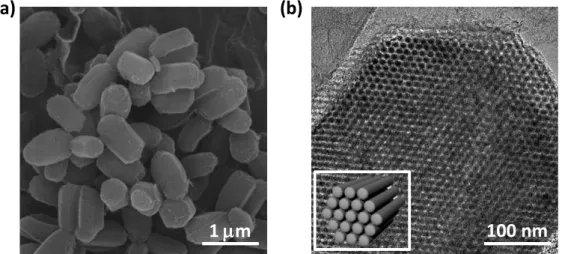
CONCLUSIONS
We found that the very high activity of FeCo-OMPC was even better than the Pt/C catalyst (Figure 5.7a,b and Table 5.3). The ORR polarization curve of FeCo-OMPC in the presence of 0.5 M methanol (Figure 5.10) showed only a small shift of the half-wave potential (30 mV). The EXAFS and XANES spectra of the GNS/MC catalyst were collected under in situ electrochemical conditions.
The Fe K-edge EXAFS spectrum of GNS/MC showed a significant decrease in the Fe-N peak at photon energy (eV). TEM image of the GNS/MC catalyst after 10 cycles of the aqueous Na-air battery cell test.
ORDERED MESOPOROUS PORPHYRINIC CARBON WITH VERY HIGH
INTRODUCTION
Therefore, the high cost together with the low durability of Pt-based catalysts led to the search for low-cost, high-performance non-precious metal catalysts. Since Jasinski reported the electrocatalytic activity of co-phthalocyanine in ORR in an alkaline medium,7 the class of non-noble metal catalysts has been a subject of continued interest.8-. This situation required a realistic comparison of the ORR activities of non-noble metal catalysts at 0.8 V41 instead of 0.9 V, where Pt-based catalysts are usually meshed.3.
Our synthetic strategy for non-noble metal catalysts included a wide range of advantages that would be favorable for PEFC applications. To the best of our knowledge, its ORR activity is one of the best among the non-noble metal catalysts reported in the literature, and even higher than the state-of-the-art Pt/C catalyst by 80% at 0.9 V (vs. reversible) hydrogen electrode, RHE).
EXPERIMENTAL SECTION
- Synthesis of Ordered Mesoporous Porphyrinic Carbons
- Characterization Methods
- Electrochemical Measurements
The morphologies of the samples were observed using a scanning electron microscope (SEM) (Quanta 200, FEI) operating at 18 kV. The microstructural and elemental analyzes of the catalyst powders were performed using HRTEM, HAADF-STEM [JEOL JEM 2100F with a probe forming Cs corrector at 200 kV (convergence angle: 30 mrad, HAADF detector semi-angles: 61-163 mrad)] , and EELS techniques (FEI Titan3 G2 cube 60-300 with an imaging Cs corrector equipped with a monochromator). The surface areas of the samples were calculated using the Brunauer-Emmett-Teller (BET) equation.
The size distribution of mesopores and micropores of the samples was calculated using the Barrett-Joyner-Halenda (BJH) and Horvath-Kawazoe (HK) algorithms, respectively. The individual chemical components of the N 1s binding energy (BE) region were fitted to the spectra with a Gaussian (Gaussian 70, Lorentzian 30) function after linear (Shirley) background subtraction.
RESULTS AND DISCUSSION
Analysis of FeCo-OMPC nitrogen adsorption (Figure 5.3) showed that the catalysts have well-developed mesoporosity and large surface areas. Comparison of half-wave potentials (E1/2), kinetic currents (ik) at 0.9 V and 0.8 V, and mass activity at 0.8 V of the FeCo-OMPC catalyst with previously reported catalysts. Corresponding kinetic currents of Pt/C and FeCo-OMPC catalysts at a scan rate of 1 mV s-1.
The ORR polarization curve of the FeCo-OMPC catalyst in 0.1 M KOH was almost identical to that of the Pt/C catalyst (Figure 5.8). Specific activity against binding energy of atomic oxygen (BO) over Pt/C and FeCo-OMPC catalysts.
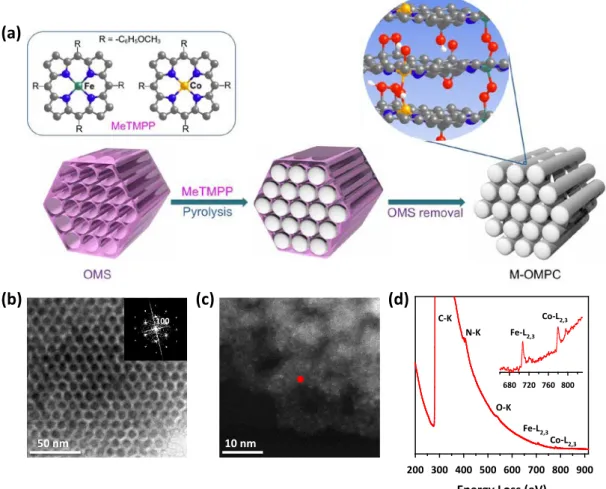
CONCLUSIONS
At an operating voltage of 0.5 V, the single cell showed an initial current density of 0.5 A cm-2. The single cell experienced decline in current density up to 40 h under operation, but after that it showed stable current density at 0.2 A cm-2. Long-term durability test for a PEFC that used FeCo-OMPC(L) cathode with a constant voltage of 0.5 V operating with H2-O2.
GRAPHITIC NANOSHELL/MESOPOROUS CARBON NANOHYBRIDS AS HIGHLY
INTRODUCTION
GNS/MC also showed very high long-term durability for OER and ORR. The high electrocatalytic performance of GNS/MC can be attributed to the contributions of residual transition metal (Ni and Fe) units, nitrogen-doped defect-rich graphitic nanoshells, and the high surface area of the mesoporous structure. Significantly, in aqueous Na-air battery tests, the GNS/MC-based cell exhibited superior performance over Ir/C and Pt/C-based cells and demonstrated the first example of rechargeable aqueous Na-air battery.
EXPERIMENTAL SECTION
- Synthesis of Graphitic Nanoshell/Mesoporous Carbon Nanohybrids
- Characterization Methods
- Electrochemical Measurements
OER and ORR activities were measured using a rotator (Pine AFMSRCE) and bipotentiostat (CHI Instruments 760E). Ring-disk electrode rotational measurements were used to determine the ORR activity and four-electron selectivity of the catalysts. OER activity was obtained in a 0.1 M KOH electrolyte saturated with N2 with CV performed for voltages ranging from 1.2 to 1.8 V at a scan rate of 5 mV s-1.
Other experimental conditions were the same as in the case of the GNS/MC catalyst, except that ORR activity data were collected from anodic sweeps. Durability tests were performed on the catalysts by applying a constant current density of 5 mA cm-2 for 20 h for OER and cycling the electrode potential between 0.6 and 1.0 V at 50 mV s-1 for 30,000 cycles for ORR.
RESULTS AND DISCUSSION
The Ni-MC, Fe-MC and OMC catalysts also exhibited similar textural characteristics to GNS/MC. We note that HR-TEM could not identify any metallic nanoparticles in GNS/MC. For OER, GNS/MC exhibited an overpotential of 340 mV to yield 10 mA cm-2 (equivalent to 10% solar-to-fuel conversion under one solar irradiation), which was significantly lower than that of monometal-doped Ni -MC ( 480 mV) and Fe-MC (500 mV).
Furthermore, GNS/MC outperformed the noble metal-based Pt/C (660 mV) and Ir/C (370 mV) catalysts. Charge/discharge curves of aqueous Na-air battery using GNS/MC coated carbon paper for 10 cycles.
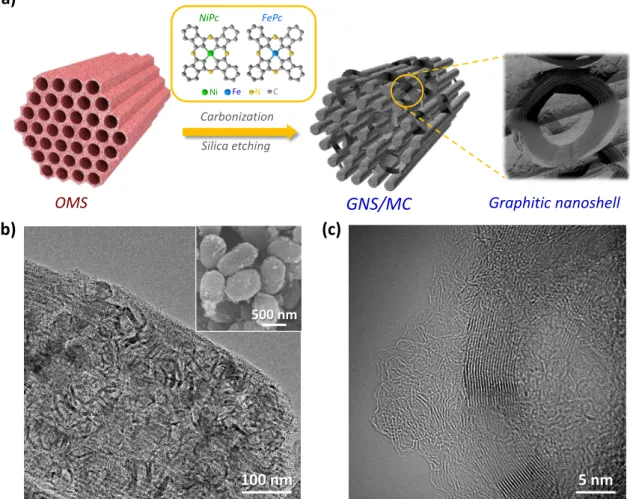
CONCLUSIONS
